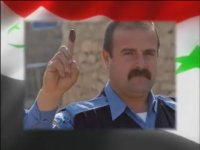Agam's Gecko


Wednesday, April 02, 2008
MORE ON 'THAT PICTURE'
| A |
commenter has provided the name of the film which is presumed to be the result of all those PLA officers issued with monks' robes in the photograph I published here. I knew I recalled reading something about this way back when, but it was further back than the 2003 publication of the photo by Tibetan Centre for Human Rights and Democracy.
The film was "Hong he gu", given the English title "Red River Valley", and was released in the run-up to the Hong Kong handover in 1997. This enabled me to find an article from Los Angeles Times in the WTN archives.
This film was released soon after the "Kundun" kerfuffle, when Disney came under serious pressure from China over that account of Dalai Lama's life. The Shanghai Film Studio rushed it's own major historical epic into production, said to be the first feature length film shot in Tibet. In dramatizing the 1904 British colonial aggression into Tibet (the Younghusband expedition), it was just the thing to stoke patriotism as Hong Kong was received back into the motherland's embrace.
"The truth is, it's not about the Dalai Lama or any other aspect of [his influence]," Medavoy said. "It's about Tibet." Medavoy added that the film itself deals with a period of Tibet's history that involved British colonialism.And also this earlier account from Tibet Information Network on the "patriotic sensation."
The film was released in China in April and did well at the box office. Chinese officials praised the film as "holding aloft the banner of patriotism in Tibet." Film minister Sun Jiazheng described the movie as "the best I have seen in my post."
Outside of some dramatic footage of the mountains, which were filmed at over 18,000 feet, others said the film had little to recommend it. One businessman who viewed the movie in China put it this way: "Typical [Communist] party drivel."
Almost all of the acting parts in the film are played by Chinese soldiers from the People's Liberation Army dressed as Tibetan soldiers, monks and British troops, and the directors and producers were also all Chinese. Two American actors, Nick Love and Paul Kersey, took parts in the film as British officers, one of whom ends by criticising the British role in Tibet.The location for shooting was the historical location of the actual events, Gyantse in southern Tibet. About 100 PLA soldiers worked as extras.
Government employees in Lhasa were all given free tickets for the movie, as part of the patriotic activities coinciding with the handover period. The same TIN report said that 10,000 people attended official celebrations in Lhasa that week.
But an unofficial source in the Tibetan capital claimed that the rally, at which government employees were expected to sing songs or perform dances to celebrate Hong Kong's return, was only given the go-ahead at the last minute because of concerns about security.From the late, lamented Tibet Information Network. Or so I thought until this morning. A website had been set up with some of the old TIN database available, but it hasn't seemed very active of late. It's active now. Added to the Tibet information resources at top of our sidebar.
"There were Chinese flags on almost every rooftop, including the Potala and the Jokhang Temple, but the celebrations were almost cancelled because of security fears and lasted less than two hours," said the source, who did not want to be named.
"Local neighbourhood committee officials went into houses and selected people at random who were then obliged to attend the festivities," he claimed. The report could not be verified. There were unconfirmed reports from another Lhasa resident of a semi-official curfew in the city from 8pm on the days leading up to the handover period, but the restriction was not formally announced and was only loosely enforced, according to the source.











 Our way of saying "thanks" in the Thai way. Here a nak muay Thai (kickboxer) offers respect and thanks for his teacher (wai khru) before a match. This is our local variation on the ubiquitous "hat tip" used in general blog culture.
Our way of saying "thanks" in the Thai way. Here a nak muay Thai (kickboxer) offers respect and thanks for his teacher (wai khru) before a match. This is our local variation on the ubiquitous "hat tip" used in general blog culture.




